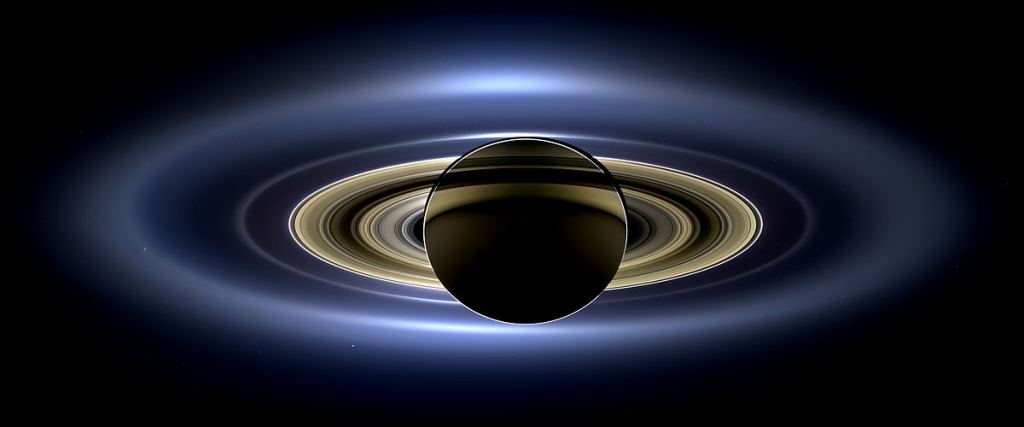Saturn is a world of surprises. The Voyager 1 and 2 flybys and later on, the Cassini mission, opened our collective eyes to intricate details in its rings and atmosphere. They also gave us up-close and personal looks at those amazing moons.
But, one thing they didn’t show us was Saturn’s proposed moon Chrysalis. That’s because it doesn’t exist. Well, actually, it is there, but in the form of those dazzling rings.
That’s the conclusion planetary scientists at MIT came to after they created a model of the Saturn system. The model included its tilt, mass, and its connection to the distant planet Neptune. When they added in the existence of a missing moon, it helped solve a few Saturnian mysteries.
The Rings Provide Clues When you look at Saturn through a telescope, the rings immediately catch your attention. They also tell you the planet is rotating at a 26. 7-degree angle with respect to the solar system’s plane.
Why so tilted? The most plausible explanation says that Saturn and Neptune were once precisely locked together by gravitational interactions. They caused Saturn’s tilt to precess at the same rate as the orbit of Neptune. Then something happened.
Today, that tilt is slightly different from in the past. So, why is that? The rings themselves are another mystery. They are NOT as old as the planet.
Some studies suggest that they could be anywhere from 10 million to 160 million years old. For reference, that means they could have formed before the first hominids appeared or as far back as the time of the dinosaurs. That makes them quite young in solar system history.
But, what happened to create them? To answer those questions, a team led by led by MIT’s Jack Wisdom created a computer simulation that modeled Saturn’s evolutionary past. A 2007 artist impression of the aggregates of icy particles that form the ‘solid’ portions of Saturn’s rings. They could be what’s left of a moon called Chrysalis.
Credit: NASA/JPL/University of Colorado Searching for A Hidden Clue The idea of a moon affecting Saturn’s tilt and breaking apart to form rings requires some pretty complex computer modeling. One piece of information the model needs is the so-called “moment of inertia”. It’s a characteristic that explains how a planet’s mass is distributed in the interior.
That distribution affects the tilt of the planet’s axis. The tilt changes if the matter is distributed more toward the core or closer to the surface. Think of Saturn as a spinning top with the poles sticking out the top and bottom of the top.
The top’s precession (or wobble) changes depending on where the mass is inside. However, Saturn’s moment of inertia wasn’t well known and the team had to determine its exact value. To get it, they used some of the last observations taken by Cassini in its “Grand Finale.
” That’s when the spacecraft made an extremely close approach to precisely map the gravitational field of the entire planet. It can be used to determine the distribution of mass inside the planet. From that data, the team modeled the interior of Saturn and identified a distribution of mass that matched the gravitational field that Cassini observed.
What they found told them that Saturn is currently close to, but just outside the resonance with Neptune. The planets may have once been in sync hundreds of millions of years ago, but they aren’t anymore. Something happened to change that.
“We went hunting for ways of getting Saturn out of Neptune’s resonance,” Wisdom said. “A missing satellite, therefore, could explain two longstanding mysteries: Saturn’s present-day tilt and the age of its rings, which were previously estimated to be about 100 million years old—much younger than the planet itself. Simulate, Simulate, Simulate The next step was to do simulations that changed the orbital dynamics of Saturn and its current 83 moons backward in time.
That allowed the team to see if any natural instabilities among the existing satellites could have influenced the planet’s tilt. It turns out none of them did. So, the team added a new moon into the mathematical equations that describe a planet’s precession (how a planet’s axis of rotation changes over time).
The idea was to put in the moon and then take it out, to see if that would affect Saturn’s precession. They ran simulations to determine the mass of the satellite, as well as its orbital radius and orbital dynamics. And, ultimately, they figured out that Saturn’s present tilt is the result of the resonance with Neptune.
The loss of the satellite, Chrysalis, which was about the size of Iapetus, allowed it to escape the resonance. Saturn’s loss was also its gain, however. Sometime between 100 and 200 million years ago, Chrysalis entered a chaotic orbital zone.
It experienced a number of close encounters with Iapetus and Titan. Eventually, it came too close to Saturn and grazed the planet. That ripped the satellite to bits, leaving pieces to circle the planet as a debris-strewn ring.
If this modeling holds up under review and follow-up modeling, then it solves two mysteries about Saturn. And, what we see today as we gaze at the planet through our telescopes could well be the remains of that tiny moon that had such an outsized influence on its more-massive planetary companion. For More Information Saturn’s Rings and Tilt Could be the Product of an Ancient, Missing MoonLoss of a satellite could explain Saturn’s obliquity and young rings The post Saturn Might Have Torn a Moon Apart to Make its Rings appeared first on Universe Today.
.
From: universetoday
URL: https://www.universetoday.com/157638/saturn-might-have-torn-a-moon-apart-to-make-its-rings/



